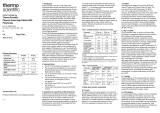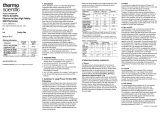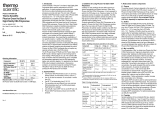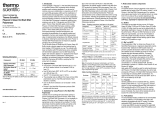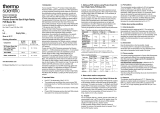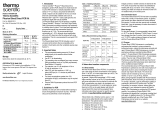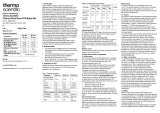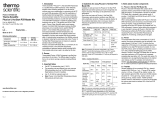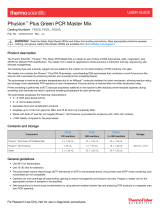Page is loading ...

PRODUCT INFORMATION
Thermo Scientific
Phusion High-Fidelity PCR Kit
Pub. No. MAN0013363
Rev. Date 27 June 2018 (Rev. C.00)
#_
Lot _ Expiry Date _
Store at -20 °C
www.thermofisher.com
For Research Use Only. Not for use in diagnostic procedures.

2
Rev.8

3
COMPONENTS OF THE KIT
Component
#F-553S
50 rxns
#F-553L
200 rxns
Phusion DNA Polymerase, 2 U/µL
25 µL
100 µL
5X Phusion HF buffer
1 × 1.5 mL
3 × 1.5 mL
5X Phusion GC buffer
1 × 1.5 mL
1 × 1.5 mL
dNTP mix, 10 mM each
100 µL
400 µL
50 mM MgCl2 solution
1.5 mL
1.5 mL
Control lambda template, 0.5 ng/mL
40 µL
40 µL
1.3 kb primers, 4 µM each
50 µL
50 µL
10 kb primers, 4 µM each
50 µL
50 µL
DNA size standard
200 µL
400 µL
DMSO
0.5 mL
0.5 mL
1. INTRODUCTION
Thermo Scientific™ Phusion™ High-Fidelity DNA Polymerase offers extreme performance for
all major PCR applications. Incorporating an exciting technology, Phusion DNA Polymerase
brings together a novel Pyrococcus-like enzyme with a processivity-enhancing domain.
Phusion DNA Polymerase generates long templates with an accuracy and speed previously
unattainable with a single enzyme, even on the most difficult templates. The extreme fidelity
makes Phusion DNA Polymerase a superior choice for cloning. The error rate of Phusion DNA
Polymerase in Phusion HF Buffer is 4.4 × 10-7 when determined with a modified lacI-based
method1. It is approximately 50-fold lower than that of Thermus aquaticus DNA polymerase
and 6-fold lower than that of Pyrococcus furiosus DNA polymerase.
The Phusion High-Fidelity PCR Kit includes lambda DNA control template and primers for
1.3 kb and 10 kb amplicons. The template amount is sufficient for performing 20 control
reactions in 50 μL volume or 50 control reactions in 20 μL volume.
2. IMPORTANT NOTES
Use 98 °C for denaturation (see 5.1 and 5.2).
The annealing rules are different from many common DNA polymerases (such as Taq DNA
polymerases). Read section 5.3 carefully.
Use 15–30 s/kb for extension. Do not exceed 1 min/kb (see 5.4).
Use Phusion DNA Polymerase at 0.5–1 U per 50 µL reaction volume. Do not exceed
2 U/50 µL (see 4.1).
Use 200 µM of each dNTP. Do not use dUTP (see 4.3).
Note: Phusion DNA Polymerases produce blunt end PCR products.

4
3. GUIDELINES FOR PHUSION DNA POLYMERASE
Phusion DNA Polymerase (2 U/μL) is provided with 5X Phusion HF Buffer and 5X Phusion GC
Buffer. Both buffers contain 1.5 mM MgCl2 at final reaction concentrations. Separate tubes of
DMSO and 50 mM MgCl2 solutions are provided for further optimization.
3.1. Basic reaction conditions for DNA amplification
Carefully mix and centrifuge all tubes before opening to ensure homogeneity and improve
recovery. PCR reactions should be set up on ice. Phusion DNA Polymerase should be pipetted
carefully and gently as the high glycerol content (50%) in the storage buffer may otherwise
lead to pipetting errors. It is critical that Phusion DNA Polymerase is the last component added
to the PCR mixture, since the enzyme exhibits 3´→5´ exonuclease activity that can degrade
primers in the absence of dNTPs.
Due to the nature of Phusion DNA Polymerase, the optimal reaction conditions may differ from
PCR protocols for standard DNA polymerases. Due to the high salt concentration in the
reaction buffer, Phusion DNA Polymerase tends to work better at elevated denaturation and
annealing temperatures. Please pay special attention to the conditions listed in section 5 when
running your reactions. Following the guidelines will ensure optimal enzyme performance.
Table 1. Pipetting instructions (add items in this order)
Component
50 µL rxn
20 µL rxn
Final conc.
H2O
add to 50 µL
add to 20 µL
5X Phusion HF Buffer*
10 µL
4 µL
1X
10 mM dNTPs
1 µL
0.4 µL
200 µM each
Primer A**
X µL
X µL
0.5 µM
Primer B**
X µL
X µL
0.5 µM
Template DNA
X µL
X µL
(DMSO***, optional)
1.5 µL
0.6 µL
3%
Phusion DNA Polymerase
0.5 µL
0.2 µL
0.02 U/µL
* Optionally 5X Phusion GC Buffer can be used, see section 4.2 for details.
** The recommendation for final primer concentration is 0.5 μM, but it can be varied in the range of 0.2-1.0 μM,
if needed.
*** Addition of DMSO is recommended for GC-rich amplicons. DMSO is not recommended for amplicons with
very low GC % or amplicons that are >20 kb.
Table 2. Cycling instructions
Cycle step
2-step protocol
3-step protocol
Cycles
Temp.
Time
Temp.
Time
Initial denaturation
98 °C
30 s
98 °C
30 s
1
Denaturation
Annealing
(see 5.3)
Extension (see 5.4)
98 °C
-
72 °C
5-10 s
-
15-30 s/kb
98 °C
X °C
72 °C
5-10 s
10-30 s
15-30 s/kb
25-35
Final extension
72 °C
4 °C
5-10 min
hold
72 °C
4 °C
5-10 min
hold
1

5
4. NOTES ABOUT REACTION COMPONENTS
4.1. Enzyme
The optimal amount of enzyme depends on the amount of template and the length of the PCR
product. Usually 1 unit of Phusion DNA Polymerase per 50 μL reaction volume gives good
results, but optimal amount can range from 0.5 to 2 units per 50 μL reaction depending on
amplicon length and difficulty. Do not exceed 2 U/50 μL (0.04 U/μL), especially for
amplicons that are >5kb.
When cloning fragments amplified with Phusion DNA Polymerase, blunt end cloning is
recommended. If TA cloning is required, it can be performed by adding A overhangs to the
blunt PCR product with Thermo Scientific Taq DNA Polymerase, for example. However, before
adding the overhangs it is very important to remove all the Phusion DNA Polymerase by
purifying the PCR product carefully. Any remaining Phusion DNA Polymerase will degrade the
A overhangs, creating blunt ends again.
4.2. Buffers
Two buffers are provided with the enzyme: 5X Phusion HF Buffer (F-518) and 5X Phusion GC
Buffer (F-519). The error rate of Phusion DNA Polymerase in HF Buffer (4.4 × 10-7) is lower
than that in GC Buffer (9.5 × 10-7). Therefore, the HF Buffer should be used as the default
buffer for high-fidelity amplification. However, GC Buffer can improve the performance of
Phusion DNA Polymerase on some difficult or long templates, such as GC-rich templates or
those with complex secondary structures. For applications such as microarray or DHPLC,
where the DNA templates need to be free of detergents, detergent-free reaction buffers
(F-520, F-521) are available for Phusion DNA Polymerases.
4.3. Mg2+ and dNTP
The concentration of Mg2+ is critical since Phusion DNA Polymerase is a magnesium
dependent enzyme. Excessive Mg2+ stabilizes the DNA double strand and prevents complete
denaturation of DNA. Excess Mg2+ can also stabilize spurious annealing of primers to incorrect
template sites and decrease specificity. Conversely, inadequate Mg2+ may lead to lower
product yield. The optimal Mg2+ concentration also depends on the dNTP concentration, the
specific template DNA and the sample buffer composition. In general, the optimal Mg2+
concentration is 0.5 to 1 mM over the total dNTP concentration for standard PCR. If the
primers and/or template contain chelators such as EDTA or EGTA, the apparent Mg2+ optimum
may be shifted to higher concentrations. If further optimization is needed, increase Mg2+
concentration in 0.2 mM steps.
High quality dNTPs should be used for optimal performance with Phusion DNA Polymerase.
The polymerase cannot read uracil derivatives or inosine in the template strand so the use of
these analogues or primers containing them is not recommended. Due to the high processivity
of Phusion DNA Polymerase there is no advantage in increasing dNTP concentrations. For
optimal results always use 200 μM of each dNTP.

6
4.4. Template
General guidelines for low complexity DNA (e.g. plasmid, lambda or BAC DNA) are: 1 pg–10 ng per
50 μL reaction volume. For high complexity genomic DNA, the amount of DNA template should be
50–250 ng per 50 μL reaction volume. If cDNA synthesis reaction mixture is used as a source of
template, the volume of the template should not exceed 10% of the final PCR reaction volume.
4.5. PCR additives
The recommended reaction conditions for GC-rich templates include 3% DMSO as a PCR
additive, which aids in the denaturing of templates with high GC contents. For further
optimization DMSO should be varied in 2% increments. In some cases DMSO may also be
required for supercoiled plasmids to relax for denaturation. Other PCR additives such as
formamide, glycerol, and betaine are also compatible with Phusion DNA Polymerase. If high
DMSO concentration is used, the annealing temperature must be decreased, as DMSO affects
the melting point of the primers. It has been reported that 10% DMSO decreases the annealing
temperature by 5.5–6.0 °C2.
5. NOTES ABOUT CYCLING CONDITIONS
5.1. Initial denaturation
Denaturation should be performed at 98 °C. Due to the high thermostability of Phusion DNA
Polymerase even higher than 98 °C denaturation temperatures can be used. We recommend a
30 second initial denaturation at 98 °C for most templates. Some templates may require longer
initial denaturation time and the length of the initial denaturation time can be extended up to
3 minutes.
5.2. Denaturation
Keep the denaturation time as short as possible. Usually 5–10 seconds at 98 °C is enough for
most templates.
Note: The denaturation time and temperature may vary depending on the ramp rate and
temperature control mode of the cycler.
5.3. Primer annealing
The optimal annealing temperature for Phusion Hot Start DNA Polymerase may differ
significantly from that of Taq-based polymerases. Always use the Tm calculator and
instructions on website: www.thermofisher.com/tmcalculator to determine the Tm values of
primers and optimal annealing temperature. If necessary, use a temperature gradient to find
the optimal annealing temperature for each template-primer pair combination. The annealing
gradient should extend up to the extension temperature (two-step PCR). A 2-step protocol is
recommended when primer Tm values are at least 69 °C (>20 nt) or 72 °C (≤20 nt) when
calculated with Thermo Fisher Scientific Tm calculator. In the 2-step protocol the combined
annealing/extension step should be performed at 72 °C even when the primer Tm is >72 °C.

7
5.4. Extension
The extension should be performed at 72 °C. Extension time depends on amplicon length and
complexity. For low complexity DNA (e.g. plasmid, lambda or BAC DNA) use an extension
time of 15 seconds per 1 kb. For high complexity genomic DNA 30 seconds per 1 kb is
recommended. For some cDNA templates, the extension time can be increased up to
40 seconds per 1 kb to obtain optimal results.
6. AMPLIFYING CONTROL TEMPLATE
6.1. Reaction conditions
Table 3. Pipetting instructions for control reactions
Component
50 µL rxn
20 µL rxn
Final conc.
H2O
34 µL
13.6 µL
5X Phusion HF Buffer
10 µL
4 µL
1X
10 mM dNTPs
1 µL
0.4 µL
200 µM each
Primers*
2.5 µL
1 µL
0.2 µM
Control template DNA
2 µL
0.8 µL
Phusion DNA Polymerase
0.5 µL
0.2 µL**
0.02 U/µL
* Either the 1.3 kb primer set or 10 kb primer set.
** Dilution of polymerase should be made to 1X reaction buffer to avoid pipetting errors.
6.2. Cycling conditions
A separate cycling protocol is given for both 1.3 kb and 10 kb control amplicons. Alternatively,
both control reactions can be amplified simultaneously using the 10 kb cycling protocol.
Table 4. Cycling conditions for 1.3 kb control fragment (2-step protocol)
Cycle step
Temp.
Time
Cycles
Initial denaturation
98 °C
1 min
1
Denaturation
Annealing/Extension
98 °C
72 °C
5 s
20 s
25
Final Extension
72 °C
10 °C
10 min
hold
1
Table 5. Cycling conditions for 10 kb fragment (3-step protocol). This program can also be
used if both control reactions are amplified simultaneously.
Cycle step
Temp.
Time
Cycles
Initial denaturation
98 °C
1 min
1
Denaturation
Annealing
Extension
98 °C
60 °C
72 °C
5 s
15 s
2 min 30 s
25
Final Extension
72 °C
10 °C
10 min
hold
1

8
The cycling protocols above are recommendations. If you wish to run these controls together
or with your experimental samples, please note that the controls have been shown to work in a
variety of conditions. The 1.3 kb control has been successfully amplified with both 2- and
3-step protocols with extension times ranging from 15 s to 5 min, and cycle numbers ranging
from 20 to 30. The 10 kb control has been successfully amplified with 3-step protocol with
extension times ranging from 2 min to 5 min, and cycle numbers ranging from 20 to 30.
6.3. Analysis of the control reactions
1 2 3 4
In the image on the left both control reactions have been run on an
ethidium bromide stained 1% agarose gel in TAE buffer. For this run
15 μL of loading dye was added to the 50 μL control PCR reactions,
and 5 μL of the resulting mixtures were loaded on the gel.
Lane 1. DNA size standard
Lane 2. 1.3 kb control amplicon
Lane 3. 10 kb control amplicon
Lane 4. DNA size standard
After running your control reactions on a gel, compare the results to
the image on the left to check for specificity and efficiency of the
reactions.

9
7. TROUBLESHOOTING
No product at all or low yield
Repeat and make sure that there are no
pipetting errors.
Use fresh high quality dNTPs.
Do not use dNTP mix that contain dUTP
or dITP or primers that contain uracil or
inosine.
Titrate template amount.
Template DNA may be damaged. Use
carefully purified template.
Increase extension time.
Increase the number of cycles.
Optimize annealing temperature.
Optimize enzyme concentration
Titrate DMSO (2–8%) in the reaction
(see section 4.5).
Denaturation temperature may be too low.
Optimal denaturation temperature for most
templates is 98 °C or higher.
Optimize denaturation time.
Check the purity and concentration of the
primers.
Check primer design.
Try using the alternative GC buffer
(see section 4.2).
If DNA is not carefully purified, inhibitors may
be present – decrease the amount of DNA.
Non-specific products - High molecular weight smears
Decrease enzyme concentration
(see section 4.1).
Make sure the extension time used was
not too long (see section 5.4).
Titrate template amount.
Reduce the total number of cycles.
Increase annealing temperature or try 2-step
protocol (see section 5.3).
Vary denaturation temperature
(see section 5.2)
Optimize Mg2+-concentration
Decrease primer concentration.
Non-specific products - High molecular weight discrete bands
Increase annealing temperature
(see section 5.3).
Shorten extension time (see section 5.4)
Decrease enzyme concentration.
Optimize Mg2+-concentration.
Titrate denaturation template amount.
Decrease primer concentration.
Design new primers.
8. COMPONENT SPECIFICATIONS
8.1. Phusion High-Fidelity DNA Polymerase (F-530)
Thermostable Phusion DNA Polymerase is purified from an E.coli strain expressing the cloned
Phusion DNA Polymerase gene. Phusion DNA Polymerase possesses the following activities:
5´→3´ DNA polymerase activity and 3´→5´ exonuclease activity. Phusion DNA Polymerase is
free of contaminating endo- and exonucleases.
Storage buffer: 20 mM Tris-HCl (pH 7.4 at 25 °C), 0.1 mM EDTA, 1 mM DTT, 100 mM KCl,
stabilizers, 200 μg/mL BSA and 50% glycerol.
Unit definition: One unit is defined as the amount of enzyme that will incorporate 10 nmoles
of dNTPs into a polynucleotide fraction at 74 °C in 30 min.
Enzyme activity is assayed in the following mixture: 25 mM TAPS-HCl, pH 9.3 (at 25 °C),
50 mM KCl, 2 mM MgCl2, 1 mM β-mercaptoethanol, 0.75 mM activated salmon milt DNA,
100 μM dTTP, 200 μM each dATP, dGTP, dCTP, 0.4 MBq/ml [3H] dTTP.

10
8.2. 5X Phusion HF Buffer (F-518)
The 5X Phusion HF Buffer contains 7.5 mM MgCl2, which provides 1.5 mM MgCl2 in final
reaction conditions.
8.3. 5X Phusion GC Buffer (F-519)
The 5X Phusion GC Buffer contains 7.5 mM MgCl2, which provides 1.5 mM MgCl2 in final
reaction conditions.
8.4. dNTP mix (F-560)
The dNTP mix is a premixed ready-to-use solution consisting of the following compounds:
dATP, dGTP, dCTP and dTTP dissolved in H2O at 10 mM each.
8.5. 50 mM MgCl2 solution (F-510MG)
Both Phusion Buffers supply 1.5 mM MgCl2 at final reaction conditions. If higher MgCl2
concentrations are desired, use 50 mM MgCl2 solution to increase the MgCl2 titer. Using the
following equation, you can calculate the volume of 50 mM MgCl2 needed to attain the final
MgCl2 concentration: [desired mM Mg] - [1.5 mM] = μL to add to a 50 μL reaction. For
example, to increase the MgCl2 concentration to 2.0 mM, add 0.5 μL of the 50 mM MgCl2
solution. Because the PCR reactions can be quite sensitive to changes in the MgCl2
concentration, it is recommended that the 50 mM MgCl2 stock solution is diluted 1:5
(to 10 mM) to minimize pipetting errors.
8.6. Lambda DNA control template (F-304K)
The control template is bacteriophage lambda DNA (GenBank access number J02459,
48 502 bp). The concentration is 0.5 ng/μL in TE buffer.
8.7. 1.3 kb control primer mix (F-535)
This component is a mix of primers for amplification of a 1.3 kb fragment of lambda DNA. Each
primer concentration is 4 μM in H2O.
Primer #1 (27-mer)
5’-GTC ACC AGT GCA GTG CTT GAT AAC AGG-3’
Melting point: 71.0 °C
Coordinates in lambda DNA: 30 006–30 032
Primer #2 (28-mer)
5’-GAT GAC GCA TCC TCA CGA TAA TAT CCG G-3’
Melting point: 73.2 °C
Coordinates in lambda DNA: 31 325–31 352

11
8.8. 10 kb control primer mix (F-536)
This component is a mix of primers for amplification of a 10 kb fragment of lambda DNA. Each
primer concentration is 4 μM in H2O.
Primer #1 (22-mer)
5’-CAG TGC AGT GCT TGA TAA CAG G-3’
Melting point: 63.5 °C
Coordinates in lambda DNA: 30 011–30 032
Primer #2 (20-mer)
5’-GTA GTG CGC GTT TGA TTT CC-3’
Melting point: 63.3 °C
Coordinates in lambda DNA: 40 024–40 043
8.9. Ready-to-use DNA standard (F-303SD)
This DNA standard is a mix of lambda DNA HindIII digest and bacteriophage φX174 DNA
HaeIII digest, each at 50 ng/μL (100 ng/μL total). It is supplied in 8 mM Tris-HCl (pH 8.0),
12 mM EDTA, 12% glycerol and 0.012% (w/v) bromophenol blue dye.
The DNA standard solution contains 19 fragments of the following sizes and mass amounts
(per 10 μL):
Fragment
Base pairs
DNA amount ng/10 μL
1
23130
238
2
9416
97
3
6557
68
4
4361
45
5
2322
24
6
2027
21
7
1353
126
8
1078
100
9
872
81
10
603
56
11
564*
6
12
310
29
13a
281
26
13b
271
25
14
234
22
15
194
18
16a
125*
1
16b
118
11
17
72
7
Note: The cohesive areas of fragments 1 and 4 can be separated by heating at 65 °C
for 5 minutes. For daily use the marker can be stored at +4 °C (at least one month). The
marker is stable at -20 °C for at least one year.
* Due to the low amount of DNA these bands are almost invisible.
8.10. Dimethyl sulfioxide DMSO, 100% (F-515)
Note: The freezing point of DMSO is 18–19 °C, so it does not melt on ice.

12
9. REFERENCES
1. Frey M. & Suppmann B. (1995) Biochemica 2: 34–35.
2. Cherster N. & Marshak D.R (1993) Analytical Biochemistry 209: 284-290.
Important Licensing Information: This product may be covered by one or more Limited Use Label Licenses.
By use of this product, you accept the terms and conditions of all applicable Limited Use Label Licenses.
PRODUCT USE LIMITATION
This product is developed, designed and sold exclusively for research purposes and in vitro use only. The
product was not tested for use in diagnostics or for drug development, nor is it suitable for administration to
humans or animals. Please refer to www.thermofisher.com for Material Safety Data Sheet of the product.
© 2018 Thermo Fisher Scientific, Inc. All rights reserved. All trademarks are the property of Thermo Fisher
Scientific Inc. and its subsidiaries.
/
